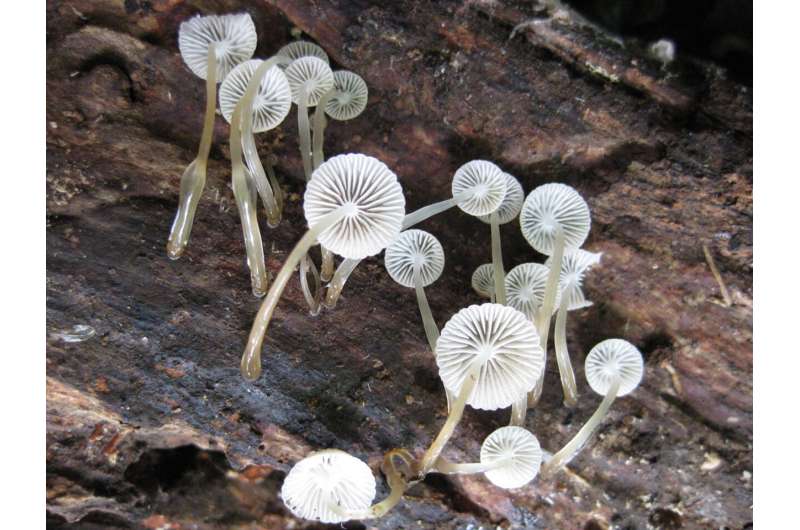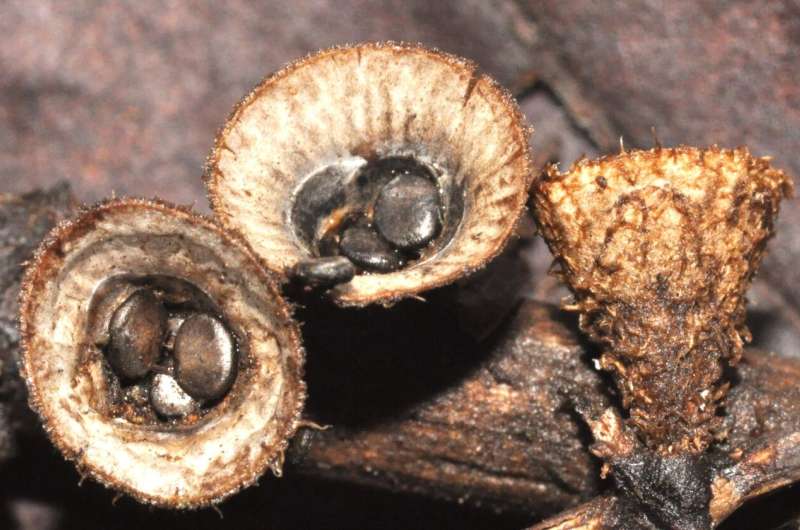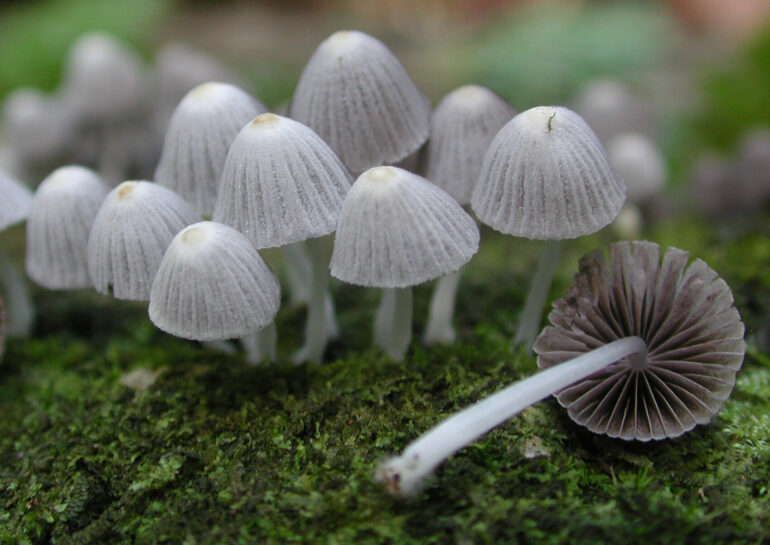The islands of the South Pacific are a hot spot for biodiversity, but their jagged peaks, hot and humid conditions, and remote locations have limited scientists’ ability to document the many fantastic forms of life in the region.
In a new study published this week in the Journal of Biogeography, researchers from the University of California, Berkeley, provide the first detailed description of the stunning array of fungi that make their home on the Polynesian island of Mo’orea. The collection includes more than 200 species of macrofungi—that is, fungi producing visible, fruiting bodies—many of which may be new to science.
“It’s like a treasure trove,” said study lead author Matteo Garbelotto, cooperative extension specialist and adjunct professor of environmental science, policy and management at UC Berkeley. “It’s truly uncharted territory in evolutionary biology and biodiversity of the fungal kingdom, and this is one the first attempts to generate baseline information on fungal diversity, not just for Mo’orea, but for the entire and vast Insular Oceania region.”
As part of the Mo’orea Biocode Project, the study team spent months trekking across the island in search of new species of fungi, ultimately gathering a total of 553 fungal specimens and sequencing the DNA of 433 of them. Because only a handful of the sequenced specimens have exact genetic matches with other known species, the Mo’orea collections are likely to contain completely new species.
By comparing the DNA sequences of these fungi to those of other species around the world, the team was also able to piece together where the fungal biodiversity on the remote island may have originated. The findings suggest that the majority of the species, or their ancestors, were carried by easterly winds from Australia or other South Pacific islands, though a small number may have been brought to Mo’orea by humans from far-flung locations like East Asia, Europe and South America.
“We were really interested in the biodiversity of the island,” said study first author Todd Osmundson, who completed the work as a postdoctoral researcher at UC Berkeley. “Mo’orea is an island in the middle of the ocean, and it’s a geologically young volcanic island. It’s never touched another piece of land. How did fungi get there, and where did they come from?”

UC Berkeley researchers carried out the first major survey of macrofungi on the Polynesian island of Mo’orea, yielding more than 500 different specimens. This Mycena sp. fungus was found growing on decaying wood. © Todd Osmundson
Understanding both the biodiversity of fungi on the island and how different species have traveled around the world to arrive at this remote location can help as scientists grapple with the ongoing impacts of global travel and trade on biodiversity.
“The Mo’orea BioCode project was the first all-taxa-survey of a tropical island to include DNA vouchers and other associated information. It included all organisms from marine and terrestrial habitats and everything larger than bacteria,” said George Roderick, William Muriece Hoskins Professor of environmental science, policy and management at UC Berkeley. “Since, the data has proven to be enormously valuable in monitoring the impacts of global change on Mo’orea but also on other tropical Pacific islands.”
‘Every day we had a different challenge’
The Mo’orea Biocode Project was led by Neil Davies, executive director of UC Berkeley’s Gump South Pacific Research Station, and ran from 2007 to 2010. One of the motivations for the project was to create a model ecosystem that could be used to answer fundamental questions about how ecosystems work.
“Fungi are really important parts of ecosystems,” said Osmundson, who is currently a professor of biology at the University of Wisconsin-La Crosse. “They act as primary decomposers, and in some cases (as) pathogens that break down decaying organic matter and recycle the nutrients into forms that other organisms can use. They’re also really important as symbionts. They live with other organisms and benefit that organism in exchange for other things. For instance, some fungi will attach to the roots of plants and exchange nutrients with them.”
To collect the specimens, the research team spent months on Mo’orea, beginning before dawn each day to gather samples of fungi from all corners of the ecosystem, including the soil, the roots and leaves of plants, and even the air.

UC Berkeley researchers carried out the first major survey of macrofungi on the Polynesian island of Mo’orea, yielding more than 500 different specimens. This bird’s nest fungus was found growing on decaying wood. © Todd Osmundson
As the heat and humidity rose throughout the day, the outdoor conditions would often become inhospitable to both the scientists and the delicate fruiting bodies of the fungi they had collected. By early afternoon, they would take their samples back to the lab and begin the process of documenting and culturing the specimens they had found, often staying up late into the night to complete their work.
“The terrain on the island is incredibly steep, and when it rains it becomes incredibly muddy, and a lot of areas are not managed. So, every day we had a different challenge,” Garbelotto said. “There are some slopes that you can only really explore on ropes. I remember being attached to a rope with my hands sticking out on the precipice, trying to collect a mushroom that was growing on a little outcrop where you couldn’t possibly walk.”
Each of the specimens was photographed and dried for storage in the University Herbarium and compared to databases of known species. As part of the biocode project, the research team also obtained DNA sequences of a specific gene that can be used as a unique “barcode” to differentiate one species from another.
“In many ways, Mo’orea is not a pristine island, and that actually makes it more interesting to me,” Garbelotto said. “The island has completely pristine areas and also has areas that have been inhabited and deeply changed by humans, starting with the arrival of Polynesians 3,000 years ago and continuing until relatively recently with the arrival of the French, the English and the Americans. Compared to places that are completely pristine, Mo’orea is more interesting to me because it’s more representative of what the world actually is.”
Additional co-authors of the paper are Sarah E. Bergemann of Middle Tennessee State University and Rikke Rasmussen, who worked on DNA sequencing as a volunteer at UC Berkeley.
More information:
Todd W. Osmundson et al, Using point data to assess biogeographical signal, endemicity and factors associated with macrofungal diversity in the data‐poor Pacific oceanic island bioregion, Journal of Biogeography (2022). DOI: 10.1111/jbi.14354
Provided by
University of California – Berkeley
Citation:
Polynesian island yields ‘treasure trove’ of fungal biodiversity (2022, March 31)



